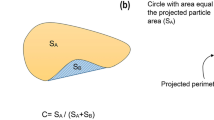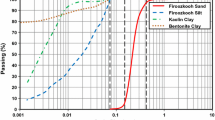Abstract
This study is an attempt to evaluate relative density and friction angle of sands on the basis of SPT-N values. In order to develop the relationships among relative density (D r ), friction angle (ϕ) and SPT-N value, field and laboratory test results from sixty boreholes executed in sandy deposit were used. The field tests include the SPTs conducted in the boreholes and the determination of in-situ density at various depths in the boreholes using the pitcher sampler whereas the laboratory tests include routine classification, direct shear box, maximum and minimum density and specific gravity tests. The SPT-N values were observed to vary between 4 and 100 and the in-situ bulk density of undisturbed samples as recovered through pitcher sampler are in the range of 13.24 ~ 18.44 kN/m3. The soil samples are classified as poorly graded sand (SP), poorly graded sand with silt (SP-SM) and silty sand (SM) on the basis of Unified Soil Classification System. The values of minimum dry unit weight fall in the range of 12.22~14.95 kN/m3 and maximum dry unit weight varies in the range of 14.64~19.17 kN/m3 as obtained through vibratory table. Based on the test results, correlation analysis was performed to identify the parameters that affect relative density. The parameters include SPT-N value corrected for field procedures (N60), relative density (D r ), void ratio range (emax–emin), effective overburden stresses (σ ’v ) and in-situ dry density (γ df ). Based on the results of correlation analyses, it was observed that SPT-N values alone cannot be related to D r . Therefore, multiple regression analysis was carried out using Statistical Package for the Social Sciences (SPSS) software and relation between relative density, corrected SPT-N value and effective overburden stress is being proposed. The variation between experimental and predicted values falls within ± 10% at 95% confidence interval. Validation of the proposed correlation was also performed by using an independent data set which indicated that the prediction by using the proposed correlation also falls within ± 10%. Further, comparison of the proposed correlation with other similar relationships already available in the literature was also performed. In addition to the above, correlation between ϕ and SPT-N60 has also been proposed. It has been observed that the experimental and predicted values of friction angle fall within ± 10% with 95% confidence interval. The proposed correlations may be very useful in the field of geotechnical engineering during feasibility/preliminary design stage for rapid estimation of relative density or friction angle based on the field SPT-N60 values.
Similar content being viewed by others
References
Bowles, J. (1968). Foundation Analysis and Design, McGraw-Hill, New York.
Cubrinovski, M. and Ishihara, K. (1999). “Empirical correlation between SPT N-value and relative density for sandy soils.” Soils and Foundations, Vol. 39, No. 3, pp. 6l–7l, DOI: 10.3208/sandf.39.5_61.
Farooq, k., Imtiaz, K., and Kibria, S. (2010), “Geotechnical zoning of Lahore for foundation design based on SPT data.” Proceedings of International Conference on Geotechnical Engineering, Pakistan Geotechnical Engineering Society, Lahore-Pakistan, pp. 167–174.
Gibbs, H. J. and Holtz, W. G. (1957). “Research on determining the density of sands by spoon penetration testing.” International Conference on Soil Mechanics and Foundation Eng., Vol. 4, No. 1, pp. 35–39.
Hatanaka, M. and Uchida, A. (1996). “Empirical correlation between penetration resistance and internal friction angle of sandy soils.” Soils and Foundations, Vol. 36, No. 4, pp. 1–9, DOI: 10.3208/sandf.36.4_1.
Hayat, K. (2003). Geotechnical Zonation and their Relation to Geology of Pakistan. PhD Thesis, Institute of Geology, Punjab University, Lahore, Pakistan.
Hettiarachchi, H. and Brown, T. (2009). “Use of SPT blow counts to estimate shear strength properties of soils: Energy balance approach.” Journal of Geotechnical and Geoenvironmental Engineering, Vol. 135, pp. 25–32, DOI: 10.1061/(ASCE)GT.1943-5606.0000016.
Japan Road Association (1990). Specification for Highway Bridges, Part V. Jianguo, C. (2012). Correlation analysis of SPT N values and cohesion and internal angle of a clay.” Soil Engineering and Foundation, Vol. 26, No. 4, pp. 91–93.
Kibria, S. and Masood, T. (1998). “SPT, Relative Density and PHI Relationships for Indus Sands at Chashma.” Proceeding of VII National Conference of Pakistan National Society for Soil Mechanics and Foundation Engineering, 169–188
Kulhawy, F. H. and Mayne, P. W. (1990). Manual on Estimating Soil Properties for Foundation Design, Final Report (EL-6800) submitted to Electric Power Research Institute (EPRI), Palo Alto, Calif.
Liao, S. and Whitman, R. V. (1986). “Overburden correction factor for SPT in sand.” Journal of Geotechnical Engineering, ASCE, Vol. 112, No. 3, pp. 373–377, DOI: 10.1061/(ASCE)0733-9410(1986)112:3(373).
Meyerhof, G. G., (1956). “Penetration tests and bearing capacity of cohesionless soils.” ASCE Journal of Geotechnical Engineering, Vol. 82, No. 1, pp. 866/1–866/19.
Mohammad, M. (2013). “Reliability of Standard Penetration Test (SPT) in predicting properties of silty clay with sand soil.” International Journal of Civil and Structural Engineering, Vol. 3, No. 3, pp. 545–556, DOI: 10.6088/ijcser.201203013050.
Peck, R. B., Hanson, W. E., and Thornburn, T. H. (1974). Foundation Engineering, 2nd ed., Wiley, New York.
Rogers, J. D. (2006). “Reliability of using Standard Penetration Test (SPT) in predicting properties of silty clay with sand soil.” Environmental & Engineering Geoscience, Vol. XII, No. 2, 161–179, DOI: 10.2113/12.2.161.
Salari, P., Lashkaripour, G. R., and Ghafoori, M. (2015). “Presentation of empirical equations for estimating internal friction angle of GW and GC soils in mashhad, iran using standard penetration and direct shear tests and comparison with previous equations.” Open Journal of Geology, No. 5, pp. 231–238, DOI: 10.4236/ojg.2015.55021.
Sivrikaya, O. and Togrol, E. (2006). “Determination of undrained shear strength of fine-grained soils by means of SPT and its application in Turkey.” Engineering Geology, Vol. 86, pp. 52–69, DOI: 10.1016/j.enggeo.2006.05.002.
Skempton, A. W. (1986). “Standard penetration test procedures and the effect in sands of overburden pressure, relative density, particle size, aging and overconsolidation.” Geotechnique, Vol. 36, No. 3, 425–447, DOI: 10.1680/geot.1986.36.3.425.
Tomlinson, M. J. (1986). Foundation Design and Construction, Longman, Singapore.
Wolff, T. F. (1989). “Pile capacity prediction using parameter functions.” in Predicted and Observed Axial Behavior of Piles, Results of a Pile Prediction Symposium, sponsored by Geotechnical Engineering Division, ASCE, Evanston, Ill., June 1989, ASCE Geotechnical Special Publication No. 23, 96–106.
Yoshida, Y. and Ikemi, M. (1988). “Empirical formulas of SPT blowcounts for gravelly soils.” Proc. 1st Int. Symposium on Penetration Testing, Rotterdam, pp. 381–387.
Author information
Authors and Affiliations
Corresponding author
Rights and permissions
About this article
Cite this article
Mujtaba, H., Farooq, K., Sivakugan, N. et al. Evaluation of relative density and friction angle based on SPT-N values. KSCE J Civ Eng 22, 572–581 (2018). https://doi.org/10.1007/s12205-017-1899-5
Received:
Accepted:
Published:
Issue Date:
DOI: https://doi.org/10.1007/s12205-017-1899-5




